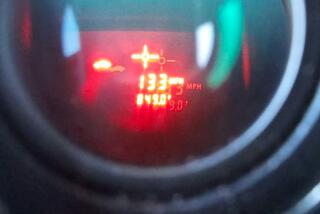In the Southland, an Open Freeway Lane Is Like a Gift From Above
- Share via
For a city that takes pride in fast-talking, fast-walking, sleep-not-required hyperactivity, New York is a bit upset about all these people who are driving way too fast.
Or at least the New York Times is, having recently featured a front-page story headlined: “Highways as Speedways? Drivers Push the Limits.” According to Federal Highway Administration data, in the five years since we abandoned the national 55-mph speed limit, more people than ever are driving at speeds over 65.
Shocking.
Despite an 11% decline in nationwide traffic fatalities in the last five years (12% in California), the N.Y. Times is quite concerned, and wants to know why all this harum-scarum rushrushrush? Can we blame it perhaps on sports-utility vehicles? Possibly, says one source. How about video games, can we blame it on video games? Why yes, says another source (oddly enough, a psychology professor from Hawaii--how many freeways are there in Hawaii, anyway?). Other slightly weird theories include toll roads (I paid good money to drive as fast as I darn well please) and still-too-low speed limits. (Make them 75 and we’ll talk, says the president of the National Motorists Assn.)
All of which ignores the obvious answer, the answer that any Angeleno would offer if anyone at that other Times had even bothered to ask: People drive over 65 because they can. Imagine finding a Southern California resident who habitually commutes to a normal-hour job at speeds above the posted limit. On a freeway.
In L.A. County, where recent studies have shown that 77% of travel time takes place under conditions of extreme congestion, defined by Caltrans as 35 mph or less, a chance to drive at 65 or over wouldn’t be a test of civic feeling, but a miracle of time and space achievable only by divine intervention. To ignore such a phenomenon would be to refuse a gift from the universe.
Here in L.A. we understand that the posted speed limit should be considered a personal average, rather than a time-specific particular. So when we’re stuck in rush-hour gridlock twice a day, five days a week, reduced to traveling at 30, 40 miles below the speed limit, it is only fair that, given a late-night opportunity on the 10, we really open her up. In fact, it’s our moral duty. To bring up the curve for everyone else, you see.
And we have a lot to make up for--a recent study by the Texas Transportation Institute discovered that motorists in the L.A. area lose 82 hours a year in delays, at an average fuel cost of $1,370 a year.
The law of averages owes us. And the debt must be paid.
In the institute’s study, New York did not even make the list of top 10 cities with the worst traffic congestion, because, as we know, most New Yorkers gave up trying to drive years ago. Which may explain the New York Times’ above-the-fold meltdown about speeding. Ever try driving down 43rd Street in Manhattan at rush hour, or any hour? Sixty-five seems a perilous speed to those who consider a cab “hurtling” when it pushes past 30. Which, in Manhattan, is only possible between midnight and 3 a.m. on weekdays, anyhow.
E-mail McNamara at mary.mcnamara@latimes.com.



